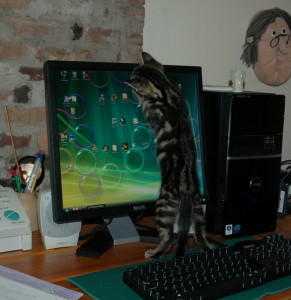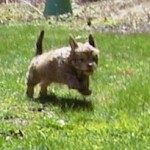 January is the Resolutions Month. At the same time the post-holiday period often doesn’t lend itself to starting big projects. Even so, the transition from holiday to daily routine does provide a good opportunity time to evaluate our interactions with our animals for any trouble spots. That way when the energy returns, the stage will be set to do what needs to be done.
January is the Resolutions Month. At the same time the post-holiday period often doesn’t lend itself to starting big projects. Even so, the transition from holiday to daily routine does provide a good opportunity time to evaluate our interactions with our animals for any trouble spots. That way when the energy returns, the stage will be set to do what needs to be done.
Let’s begin 2015 by considering two kinds of stealth animal behavioral problems that holidays may expose.
Size Matters
Regardless of species, young animals will get bigger as they get older. For example, if you keep your animal-radar on when you surf the web or engage in social media, it won’t take long before you see pictures or videos of a variety of animals who have taken over human beds, couches, or chairs. In some instances the animals began sleeping in those locations as youngsters because they were ill or otherwise needed close monitoring for some reason. Similarly, many people find some reason to hold young animals in their laps in the car for the trip to the animal’s new home. Usually a passenger in the vehicle does this, but sometimes drivers may succumb to the temptation to do this too. In these situations we often tell ourselves we do this to comfort the animal. But most people admit they enjoyed doing this a great deal, and sometimes even more than the animal.
But as the animal grows, enjoyment can turn to annoyance. Mary gets tired of shoving the dog out of the way on the bed so she can get some sleep. John discovers that any pleasure he experienced riding or driving with his puppy in his lap vanished when the dog turned into a 40-pound adult. In addition to a dog of that size literally weighing him down, his pet became a very real safety hazard.
Other interactions with young animals become established because initially they make us laugh.These include puppies jumping up on us, and kittens  climbing up our jeans, sleeping on our heads, or making kamikaze leaps onto our backs and clawing their way to our necks. When the puppy’s jumping up becomes an attention-getting display capable of ruining clothing and knocking people down, suddenly it’s not funny anymore. Even though Kim thought it was funny when her 3-pound kitten slept on her head, when the now 15-pound adult nests there she finds it much more irritating than humorous.
climbing up our jeans, sleeping on our heads, or making kamikaze leaps onto our backs and clawing their way to our necks. When the puppy’s jumping up becomes an attention-getting display capable of ruining clothing and knocking people down, suddenly it’s not funny anymore. Even though Kim thought it was funny when her 3-pound kitten slept on her head, when the now 15-pound adult nests there she finds it much more irritating than humorous.
In these examples perceived positive choices people made regarding a young animal come back to haunt in the form of problem animal behavior and all the human fallout associated with it when the animal matured.
Human-Animal Displays Not Ready for Prime Time
The majority of these displays traditionally evolved in the private, either deliberately or unwittingly. But for better or worse, videos of these behaviors increasingly show up on the Internet. Some are relatively benign, such as singing or dancing with pets. Personalized feeding rituals also are fairly common and run the gamut from making animals display unrelated behaviors to earn the food, to sharing food, to teaching animals to eat with utensils.
At the edge of the spectrum are those who encourage animals to take food directly from their mouths. There also are those who share quality time with their pets while engaging in a full range of personal hygiene activities, the exact details of which I’ll leave to your imagination.
Once again context determines perception of these human and animal interactions. Complex interactions and rituals that may be highly rewarding for those who live alone with their animals may become a source of great distress if a Prince or Princess Charming enters their lives. Other times such interactions may drive off housemates vital for survival at a time of economic downturn.
Another fairly common unintended consequence of these interactions occurs when these people and their animals must be separated for some reason. When this happens, those same interactions may make it difficult to kennel the animal or find a pet-sitter willing to engage in such displays. Other times people feel so embarrassed about the nature of the interaction that they don’t reveal its existence to any caregivers. Whether the separation is the result of necessity or a long awaited vacation, owner and animal may suffer. Abbie feels guilty because she was too embarrassed to mention her elaborate feeding ritual to her cat-sitter; her cat is so confused in its absence, he refuses to eat at all. Meanwhile the time others spend separated from their animals may be filled with fears that the animal will do something that will cause the caregiver to wonder what animal and the owner engage in behind closed doors.
Gearing up to Solve the Problem
Once you identify a problem related to your animal, next you need to get yourself in the right frame of mind to deal with it by addressing these 3 key points:
- Eliminate any negative emotions because they’re energy vampires and you’re going to need all your energy to resolve the problem.
- Frame the problem as a challenge for you and the animal, an opportunity to learn new things about each other and yourselves. Seeing the problem as evidence of failure on your or your animal’s part will only deplete your energy supply too.
- Accept responsibility for initiating any program of change and seeing it through to the end. To help you do this, make this your mantra: My animal, my problem, my responsibility. This doesn’t mean that you can’t or shouldn’t seek help if you need it. You should. But if you want an animal who’s well- behaved with you and others in multiple environments, ultimately you’re the most important person involved in that transformation.
Once you identify any problems and nail these basics, you’re ready to make 2015 a year of successful new beginnings for you and your animal.
Let’s begin 2015 by considering two kinds of stealth animal behavioral problems that holidays may expose.
Size Matters
Regardless of species, young animals will get bigger as they get older. For example, if you keep your animal-radar on when you surf the web or engage in social media, it won’t take long before you see pictures or videos of a variety of animals who have taken over human beds, couches, or chairs. In some instances the animals began sleeping in those locations as youngsters because they were ill or otherwise needed close monitoring for some reason. Similarly, many people find some reason to hold young animals in their laps in the car for the trip to the animal’s new home. Usually a passenger in the vehicle does this, but sometimes drivers may succumb to the temptation to do this too. In these situations we often tell ourselves we do this to comfort the animal. But most people admit they enjoyed doing this a great deal, and sometimes even more than the animal.
But as the animal grows, enjoyment can turn to annoyance. Mary gets tired of shoving the dog out of the way on the bed so she can get some sleep. John discovers that any pleasure he experienced riding or driving with his puppy in his lap vanished when the dog turned into a 40-pound adult. In addition to a dog of that size literally weighing him down, his pet became a very real safety hazard.
Other interactions with young animals become established because initially they make us laugh.These include puppies jumping up on us, and kittens climbing up our jeans, sleeping on our heads, or making kamikaze leaps onto our backs and clawing their way to our necks. When the puppy’s jumping up becomes an attention-getting display capable of ruining clothing and knocking people down, suddenly it’s not funny anymore. Even though Kim thought it was funny when her 3-pound kitten slept on her head, when the now 15-pound adult nests there she finds it much more irritating than humorous.
climbing up our jeans, sleeping on our heads, or making kamikaze leaps onto our backs and clawing their way to our necks. When the puppy’s jumping up becomes an attention-getting display capable of ruining clothing and knocking people down, suddenly it’s not funny anymore. Even though Kim thought it was funny when her 3-pound kitten slept on her head, when the now 15-pound adult nests there she finds it much more irritating than humorous.
In these examples perceived positive choices people made regarding a young animal come back to haunt in the form of problem animal behavior and all the human fallout associated with it when the animal matured.
Human-Animal Displays Not Ready for Prime Time
The majority of these displays traditionally evolved in the private, either deliberately or unwittingly. But for better or worse, videos of these behaviors increasingly show up on the Internet. Some are relatively benign, such as singing or dancing with pets. Personalized feeding rituals also are fairly common and run the gamut from making animals display unrelated behaviors to earn the food, to sharing food, to teaching animals to eat with utensils.
At the edge of the spectrum are those who encourage animals to take food directly from their mouths. There also are those who share quality time with their pets while engaging in a full range of personal hygiene activities, the exact details of which I’ll leave to your imagination.
Once again context determines perception of these human and animal interactions. Complex interactions and rituals that may be highly rewarding for those who live alone with their animals may become a source of great distress if a Prince or Princess Charming enters their lives. Other times such interactions may drive off housemates vital for survival at a time of economic downturn.
Another fairly common unintended consequence of these interactions occurs when these people and their animals must be separated for some reason. When this happens, those same interactions may make it difficult to kennel the animal or find a pet-sitter willing to engage in such displays. Other times people feel so embarrassed about the nature of the interaction that they don’t reveal its existence to any caregivers. Whether the separation is the result of necessity or a long awaited vacation, owner and animal may suffer. Abbie feels guilty because she was too embarrassed to mention her elaborate feeding ritual to her cat-sitter; her cat is so confused in its absence, he refuses to eat at all. Meanwhile the time others spend separated from their animals may be filled with fears that the animal will do something that will cause the caregiver to wonder what animal and the owner engage in behind closed doors.
Gearing up to Solve the Problem
Once you identify a problem related to your animal, next you need to get yourself in the right frame of mind to deal with it by addressing these 3 key points:
Once you identify any problems and nail these basics, you’re ready to make 2015 a year of successful new beginnings for you and your animal.